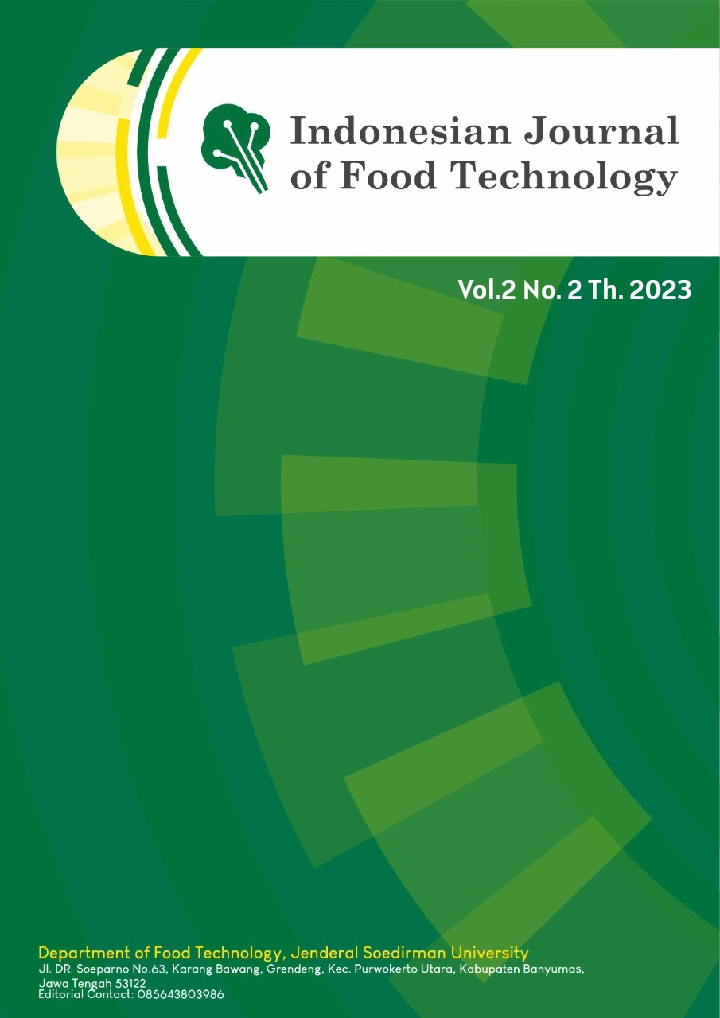The Effect of Adding Barley Flour (Setaria italica L.) on Sago Cookies Products (Metroxylon Sp.) as an Innovation in Local Food Products
Abstract
This study aims to determine the effect of adding barley flour (Setaria italica L.) to sago cookies (Metroxylon Sp.) as an innovation in local food products. The design experimental used in this study was a Completely Randomized Design (CRD) with four formulation and four replications. The research parameters consisted of organoleptic properties using five scales and chemical analysis, including moisture, ash, fat, protein, carbohydrate, and crude fiber. Data were analyzed using the Analysis of Variance (ANOVA) statistical analysis; the values were significantly different between the sample, followed by Duncan's with a level of 5%. The results obtained from this study were that adding barley flour to sago cookies had a significant effect on aroma, texture, taste, and overall, while color had no significant effect. The formulation that received the highest rating from the panelists was cookies with a formulation with 60% sago starch and 40% barley flour. The study indicated that adding barley flour to sago cookies increased the water, ash, fat, protein, and crude fiber content but decreased total carbohydrate. The average chemical characteristics results of sago cookies with the addition of barley flour showed a moisture content 3.33 - 6.58 %, ash 2.31 - 2.79 %, fat 15.78 - 18.48 %, protein 4 .64 - 9.91 %, total carbohydrate 62.23 - 73.93 % and crude fiber 6.94 - 10.23 %. The best cookies with a formulation of 60 % sago starch and 40 % barley flour.
References
Dwi, W. K., & Wulandari, A. (2022). Analisa Proksimat Cookies Dengan Substitusi Tepung Lokal. Agrointek : Jurnal Teknologi Industri Pertanian, 16(1), 96–103. https://doi.org/10.21107/agrointek.v16i1.12562
Hemeto, C. A., Ahmad, L., Tp, S., Si, M., Maspeke, P. N. S., & Tp, S. (2019). Analisis Kandungan Gizi Cookies Sagu Yang Difortifikasi Dengan Tepung Ikan Nike (Awaous melanocephalus) (Kajian Diversifikasi Produk Pangan Lokal). Jambura Journal of Food Technology, 1(1), 10–12.
Indrastuti, Al Islamiyah, S., & Basma, V. C. (2023). Nutrisi dan Kualitas Sensori Produk Sereal Jewawut Dengan Subsitusi Teh Hijau. Ilmu Gizi Dan Riset Kesehatan, 1(2), 13–20.
Leksono, A., & Nugraheni, M. (2019). Pengembangan Sponge Cake Kaya Serat Dengan Tepung Jewawut. Prosiding Pendidikan Teknologi Fashion, 14(1).
Muhammad, D. R. A., Sasti, T. G., & Anandito, R. B. K. (2019). Karakteristik Brownis Kukus Cokelat Berbahan Dasar Pati Garut Dengan Subtitusi Parsial Tepung Jewawut. Jurnal Teknologi Hasil Pertanian, 12(2), 87–98.
Mulyanto, B. P., Wulandari, Y. W., & Mustofa, A. (2020). Karakteristik Brownies Kukus Tepung Jewawut (Setarica Italica) Dan Tepung Maizena Dengan Pengaruh Lama Proses Pengukusan. Jurnal Teknologi Dan Industri Pangan, 5(1), 56–66. https://doi.org/10.33061/jitipari.v5i1.3131
Nadimin, N., Sirajuddin, S., & Fitriani, N. (2019). Mutu Organoleptik Cookies Dengan Penambahan Tepung Bekatul Dan Ikan Kembung. Media Gizi Pangan, 26(1), 8. https://doi.org/10.32382/mgp.v26i1.991
Ningrum, A. S., & Aqil, M. (2017). Karakteristik Tepung Jewawut (Foxtail Millet) varietas Lokal Majene dengan Perlakuan Perendaman. Jurnal Penelitian Pascapanen Pertanian, 14(1), 11–21
Nurjanah, S. S., Hidayat, T., Ekawati, Y., Paramudhita, P. S., & Arifianto. (2015). Change Composisition chemical of skipjack tuna due to frying process. International Food Research Journal, 2(5), 2093–2102
Prasetyaningsih, Y., Sari, M. W., & Ekawandani, N. (2018). Pengaruh Suhu Pengeringan dan Laju Alir Udara terhadap Analisis Proksimat Penyedap Rasa Alami Berbahan Dasar Jamur untuk Aplikasi Makanan Sehat (Batagor). Eksergi, 15(2), 41–47
Ramadhani, F., & Murtini, E. S. (2017). Pengaruh Jenis Tepung Dan Penambahan Perenyah Terhadap Karakteristik Fisikokimia Dan Organoleptik Kue Telur Gabus Keju. Jurnal Pangan dan Agroindustri, 5(1), 38–47
Ramdany, R., Kamaruddin, M., Pongoh, A., & Suryani, E. A. (2021). Daya Terima dan Kandungan Gizi Cookies Tepung Sagu Kombinasi Tepung Kacang Merah Dengan Penambahan Sari Buah Merah. Jurnal Health Sains, 2(2), 235–241
Setiadi, Y., Sunarto, & Hutagalung, S. P. (2015). Potensi Tepung Jewawut dalam Meningkatkan Kadar Fe dan Akseptabilitas Chicken Nugget. Jurnal Riset Kesehatan, 4(2), 756–762
Suarni, S., Aqil, Muh., & Subagio, H. (2019). Potensi Pengembangan Jagung Pulut Mendukung Diversifikasi Pangan. Jurnal Penelitian dan Pengembangan Pertanian, 38(1), 1. https://doi.org/10.21082/jp3.v38n1.2019.p1-12
Suarni, & Yasin, M. (2011). Jagung sebagai Sumber Pangan Fungsional. Iptek Tanaman Pangan, 6, 41–56
Sukandar, D., Muawanah, A., Amelia, E. R., & Basalamah, W. (2014). Karakteristik Cookies Berbahan Dasar Tepung Sukun (Artocarpus communis) Bagi Anak Penderita Autis. Jurnal Kimia VALENSI, 4(1). https://doi.org/10.15408/jkv.v4i1.1047
Sulistyaningrum, A., Hayati, N. Q., Rahmawati, & Darudriyo. (2020). Analisis Linearitas Proporsi Tepung Jewawut Terhadap Karakterisik Fisik Dan Kimia Brownies Bakar. Informatika Pertanian, 29(1), 23. https://doi.org/10.21082/ip.v29n1.2020.p23-32
Suparmi, S., Sumarto, S., Sari, N. I., & Hidayat, T. (2021). Pengaruh Kombinasi Tepung Sagu dan Tepung Udang Rebon terhadap Karakteristik Kimia dan Organoleptik Makaroni: Characteristics of makaroni based on sago flour, combined with rebon shrimp flour (Acetes erythraeus). Jurnal Pengolahan Hasil Perikanan Indonesia, 24(2), 218–226. https://doi.org/10.17844/jphpi.v24i2.35059
Suryono, M., Harijono, & Yunianta. (2013). Pemanfaatan ikan tuna (yellowfin tuna), ubi jalar (Ipomea batatas) dan sagu (Metroxylon sago) dalam pembuatan kamaboko. Jurnal Teknologi Pertanian, 14(1), 9–20
Susanti, E., Saragih, B., & Yuliani, Y. (2022). Pengaruh perbandingan tepung terigu dan tepung jewawut (Setaria italica L.) terhadap sifat organoleptik, sifat fisik dan karotenoid donat labu kuning. Journal of Tropical AgriFood, 3(2), 79–85











